You’ll discover that choosing the right hedge plants can transform your outdoor space from ordinary to extraordinary. Whether you’re seeking privacy, defining boundaries, or creating visual interest, these nine carefully selected varieties offer solutions for every landscaping need. From the towering 15-foot Emerald Green Arborvitae to the compact 3-foot Boxwood, each plant brings unique characteristics that can enhance your property’s aesthetic appeal and functionality. Let’s explore how these versatile options can revolutionize your landscape design.
Contents
- 1 Emerald Green Arborvitae: The Classic Privacy Solution
- 2 Portuguese Laurel: Elegant Year-Round Screening
- 3 Flowering Dogwood: Beauty Meets Boundary
- 4 Privet Hedges: Fast-Growing Formal Borders
- 5 Red Twig Dogwood: Winter Interest and Summer Shade
- 6 Boxwood: Sculpting Your Garden’s Architecture
- 7 Holly Varieties: Berries and Boundaries Combined
- 8 Japanese Yew: Shade-Tolerant Screening
- 9 Butterfly Bush: Living Fences That Attract Wildlife
Emerald Green Arborvitae: The Classic Privacy Solution

Emerald Green Arborvitae is a dense, columnar evergreen that grows in a perfectly uniform shape, making it one of the most popular choices for privacy hedges. These slow-growing trees reach heights of 12-15 feet with a spread of 3-4 feet, featuring bright emerald-green foliage that maintains its color year-round.
The soft, scale-like leaves create a thick, luxurious appearance that provides excellent screening while adding architectural interest to the landscape.
- Light Requirements: Full sun to partial shade, with best growth in full sun
- Soil Needs: Well-draining, slightly acidic soil with pH 6.0-8.0
- Water Requirements: Regular watering until established; moderate thereafter
- Hardiness Zones: 4-8
- Spacing: Plant 3-4 feet apart for hedge formation
- Growth Rate: 6-9 inches per year
Regular maintenance of Emerald Green Arborvitae focuses on preventing damage and maintaining shape.
Prune in early spring before new growth appears, removing dead or yellowed branches and shaping the top and sides to maintain the desired height and width.
Apply a layer of mulch around the base to retain moisture and suppress weeds, but keep it away from the trunk to prevent rot.
During extended dry periods, deep watering is essential to prevent the internal branches from dying out, which can create permanent bare spots in the hedge.
Portuguese Laurel: Elegant Year-Round Screening
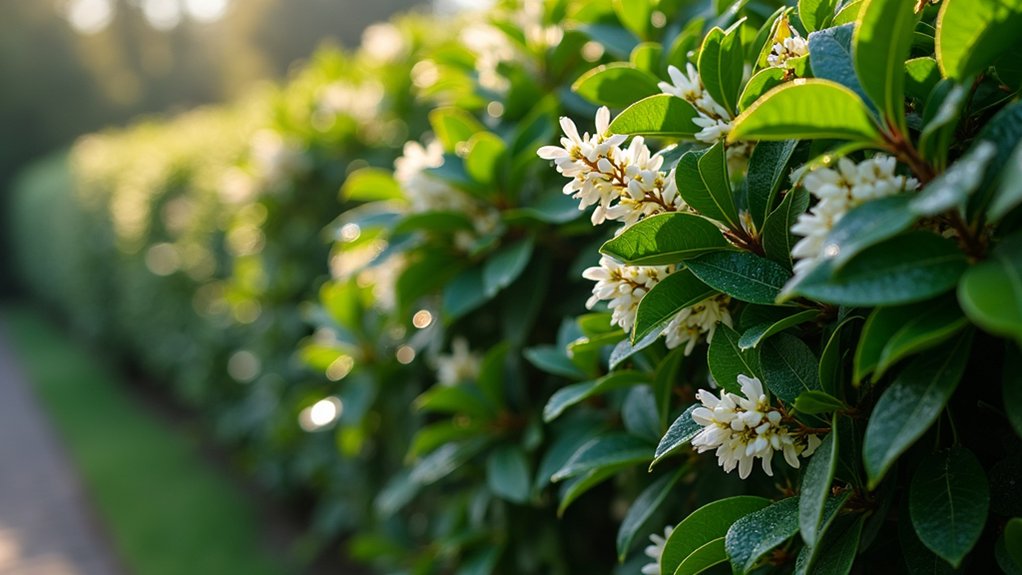
Portuguese Laurel (Prunus lusitanica) is a sophisticated evergreen shrub that creates a dense, formal hedge with glossy, dark green leaves and an upright growth habit. Its elegant appearance is enhanced by white flower racemes in late spring, followed by small dark berries, providing year-round visual interest.
The plant’s thick foliage and rapid growth rate make it an excellent choice for privacy screening, while its ability to withstand pollution makes it suitable for urban settings.
Growing Conditions:
- Light: Thrives in full sun to partial shade
- Soil: Well-draining, slightly acidic to neutral soil
- Water: Moderate water needs; establish regular watering schedule when young
- Hardiness: USDA zones 6-9
- Height: Can reach 15-30 feet if left unpruned
- Spacing: Plant 3-4 feet apart for hedge formation
Maintaining Portuguese Laurel requires regular pruning twice yearly to maintain desired shape and prevent leggy growth.
Early spring pruning promotes dense growth, while late summer trimming helps maintain form. Remove any damaged or crossing branches to improve air circulation and prevent disease.
Apply a balanced fertilizer in spring and mulch around the base to retain moisture and suppress weeds, keeping the mulch away from the trunk to prevent rot.
Monitor for signs of leaf spot or scale insects, treating promptly if detected.
Flowering Dogwood: Beauty Meets Boundary
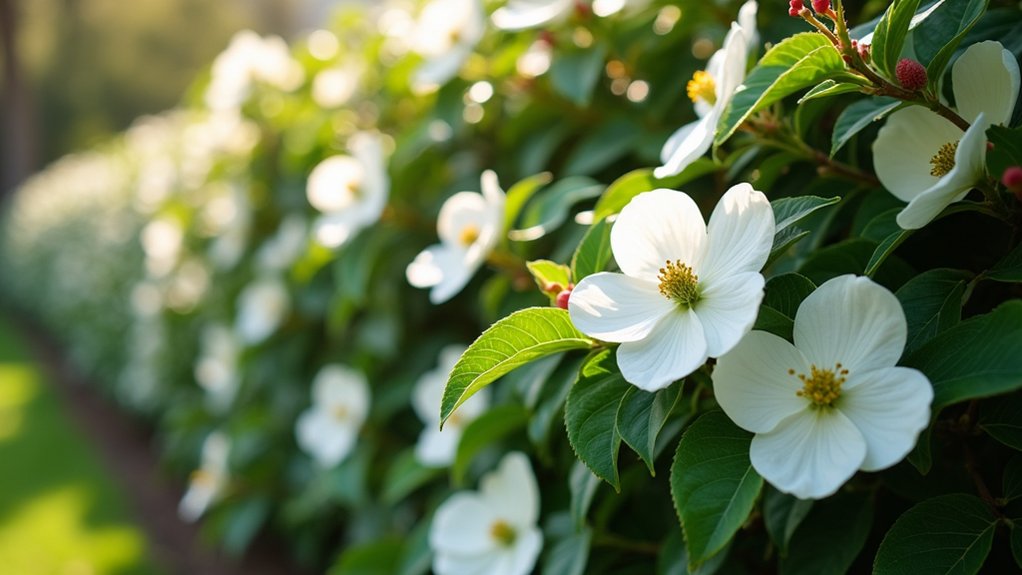
Flowering Dogwood offers a stunning combination of privacy and ornamental appeal as a hedge choice. These deciduous shrubs showcase layered branches adorned with distinctive white or pink spring blooms, followed by lush green foliage that transforms into deep burgundy in fall. The plant’s horizontal branching pattern creates an effective natural screen while providing seasonal interest through flowers, berries, and autumn color.
- Light: Partial shade to full sun, with protection from intense afternoon sun
- Soil: Well-draining, rich, slightly acidic soil (pH 5.5-6.5)
- Water: Regular watering to maintain consistently moist soil, not waterlogged
- Temperature: Hardy in USDA zones 5-9
- Spacing: Plant 6-8 feet apart for hedge formation
- Height: Can grow 15-25 feet tall when mature
Regular pruning is essential to maintain the desired hedge shape and promote dense growth, best performed immediately after flowering to preserve next year’s blooms.
Remove any dead, diseased, or crossing branches during late winter dormancy.
Apply a 2-3 inch layer of organic mulch around the base while keeping it away from the trunk to retain moisture and suppress weeds.
Monitor for common issues like dogwood anthracnose and powdery mildew, ensuring proper air circulation between plants to prevent fungal problems.
Privet Hedges: Fast-Growing Formal Borders
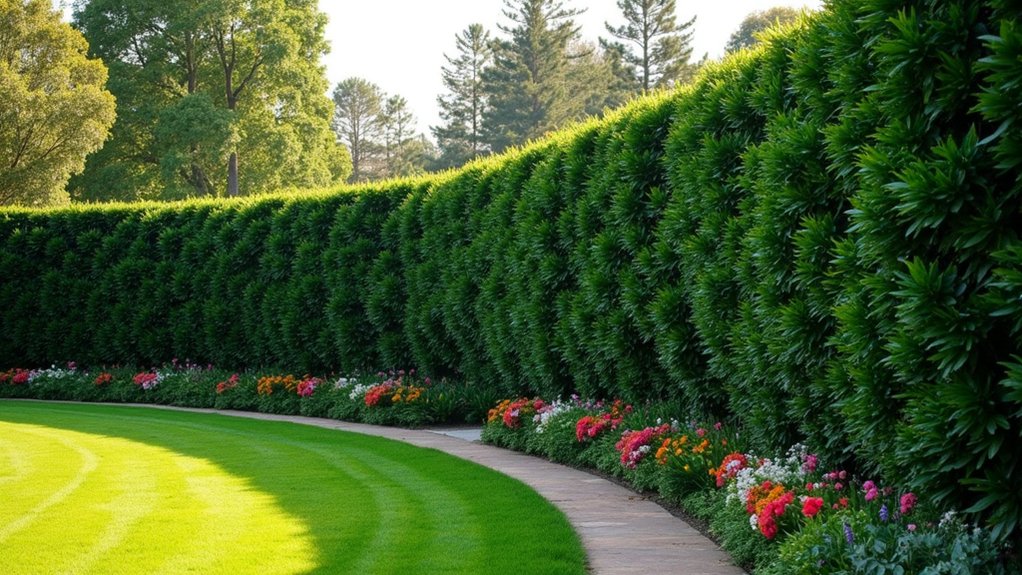
Privet hedges (Ligustrum species) are renowned for their dense, uniform growth and glossy oval leaves, making them a classic choice for formal borders and privacy screens. These fast-growing shrubs can reach heights of 4-15 feet and create an impressive living wall within a few seasons. Their small white flowers appear in late spring, followed by dark berries, though most gardeners trim them before flowering to maintain a crisp, manicured appearance.
- Light: Full sun to partial shade; best growth in full sun
- Soil: Well-draining, fertile soil; adaptable to most soil types
- Water: Regular watering until established; moderate drought tolerance once mature
- pH: Tolerates 5.0-8.0
- Temperature: Hardy in zones 5-8 (varies by species)
- Spacing: 12-24 inches apart for dense hedge formation
- Growth Rate: 2-3 feet per year in optimal conditions
Regular maintenance is crucial for keeping privet hedges looking their best. Trim the hedges 2-3 times during the growing season, starting in late spring, making sure the top is slightly narrower than the base to allow light penetration to all parts of the hedge.
Remove dead or damaged branches in early spring, and apply a balanced fertilizer before new growth begins. Deep watering during extended dry periods and applying a 2-3 inch layer of mulch around the base (keeping it away from the stems) will help maintain consistent soil moisture and suppress weed growth.
Red Twig Dogwood: Winter Interest and Summer Shade

Red Twig Dogwood (Cornus sericea) offers year-round visual interest with its most striking feature being bright red stems that illuminate winter landscapes.
During summer, the shrub displays oval, dark green leaves that provide dense shade, while small white flower clusters bloom in late spring, followed by white berries that attract birds. The plant’s most dramatic transformation occurs when its leaves drop in autumn, revealing the vivid red branches that give this dogwood its common name.
Growing Conditions:
- Light: Full sun to partial shade; redder stems develop with more sun exposure
- Soil: Moist, well-draining soil with rich organic matter
- Water: Regular watering needed; tolerates wet conditions
- Hardiness: USDA zones 2-8
- Height: 6-9 feet tall
- Spread: 8-12 feet wide
- pH: Adaptable to both acidic and alkaline soils (5.5-7.0)
Regular pruning is essential for maintaining Red Twig Dogwood‘s health and appearance.
Remove about one-third of the oldest stems at ground level each spring to encourage new growth, as the youngest branches display the brightest red color. Cut back damaged or crossing branches, and thin out the center of the shrub to improve air circulation.
During extended dry periods, provide supplemental water and apply a 2-3 inch layer of mulch around the base to retain moisture and suppress weeds, keeping the mulch several inches away from the stems to prevent rot.
Boxwood: Sculpting Your Garden’s Architecture
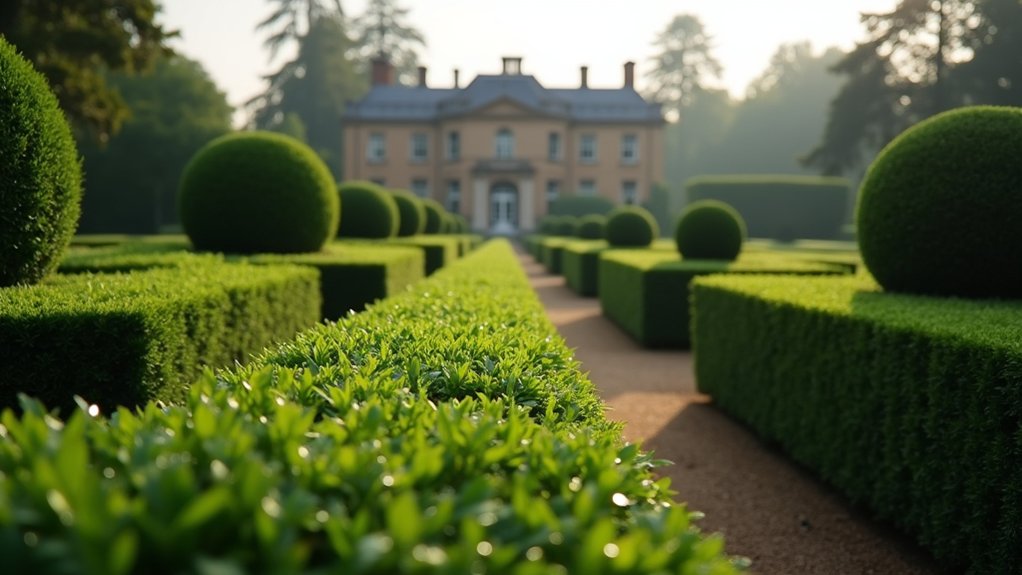
Boxwood shrubs are quintessential hedge plants, known for their dense, evergreen foliage and exceptional ability to maintain crisp, formal shapes. These slow-growing plants feature small, glossy leaves that create a tight, uniform surface perfect for geometric designs, topiary art, and formal garden borders. Their versatile nature allows them to serve as both low borders and tall privacy screens, depending on the variety chosen.
- Light: Partial to full sun, with afternoon shade in hot climates
- Soil: Well-draining, slightly acidic to neutral pH (6.0-7.0)
- Water: Regular watering until established; moderate thereafter
- Hardiness: Zones 5-8 (varies by species)
- Spacing: 2-3 feet apart for hedges
- Fertilizer: Light feeding in spring with balanced fertilizer
- Growth Rate: Slow to moderate, 6 inches or less per year
Regular maintenance is crucial for keeping boxwood hedges looking their best. Prune twice yearly – in spring after the threat of frost has passed and again in mid-summer – to maintain desired shape and encourage dense growth.
Remove dead or yellowing branches promptly to prevent boxwood blight, and clear fallen debris from the base of the plants to improve air circulation. During winter in colder regions, protect plants from harsh winds and winter burn by installing burlap screens or applying an anti-desiccant spray to the foliage.
Holly Varieties: Berries and Boundaries Combined
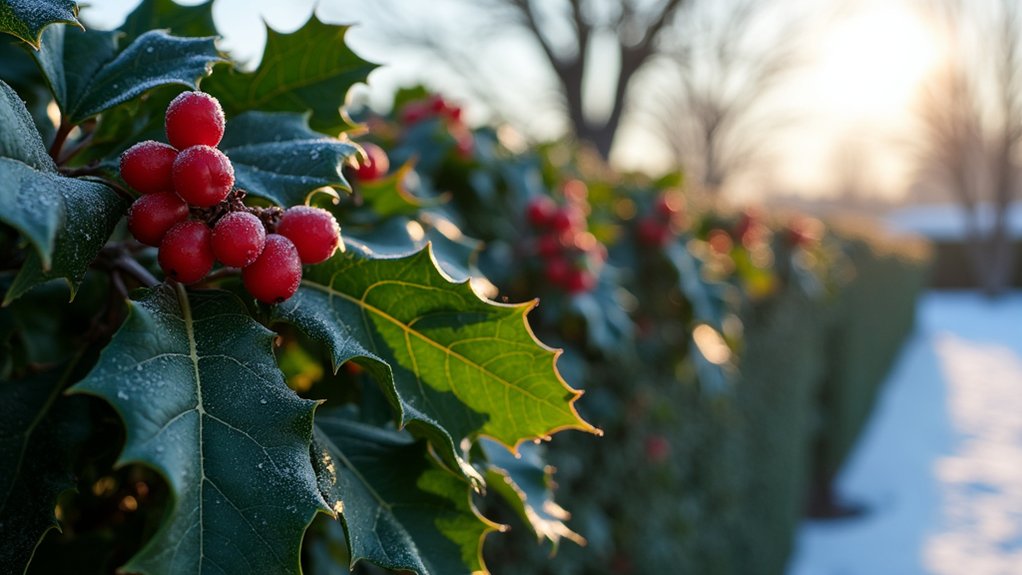
Holly varieties offer excellent year-round screening while providing seasonal interest through their glossy evergreen foliage and bright winter berries. These dense shrubs create formal-looking boundaries with their naturally compact growth habit, reaching heights between 6-50 feet depending on the variety.
Female plants produce the characteristic red, orange, or yellow berries when male plants are nearby for pollination, making them not only functional as privacy screens but also valuable for winter garden aesthetics and wildlife habitat.
Growing Conditions:
- Full sun to partial shade, with best berry production in full sun
- Moderate watering needs; soil should be kept consistently moist but not waterlogged
- Well-draining, acidic soil with pH between 5.0-6.0
- Tolerates various soil types but prefers rich, organic matter
- Protection from harsh winds in colder regions
- USDA hardiness zones 5-9, depending on variety
Regular pruning in late winter or early spring helps maintain the desired hedge shape and promotes dense growth.
Remove any dead, diseased, or crossing branches to improve air circulation and prevent fungal issues. Since holly plants are dioecious, plant both male and female specimens if berry production is desired, typically one male plant for every five to ten females.
Apply a layer of mulch around the base to retain moisture and suppress weeds, but keep it away from the trunk to prevent rot. Annual fertilization with an acid-forming fertilizer in spring supports healthy growth and abundant berry production.
Japanese Yew: Shade-Tolerant Screening
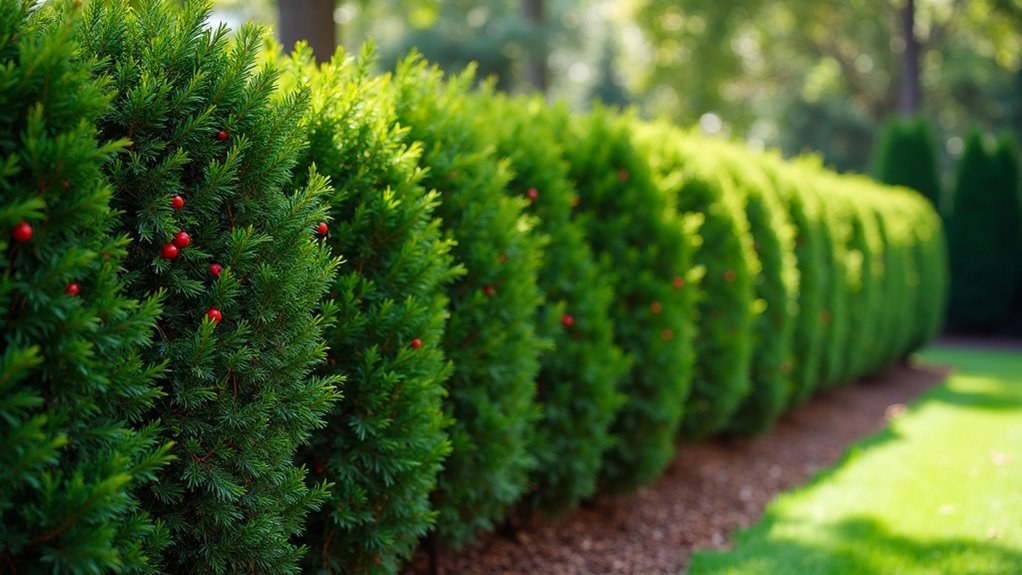
Japanese Yew (Taxus cuspidata) stands as a versatile evergreen hedge plant, prized for its ability to thrive in shaded areas where other screening plants struggle. This dense shrub features dark green needles, creating a rich, textural backdrop that maintains its color year-round. Growing to heights between 10-25 feet with a spread of 5-10 feet, Japanese Yew produces bright red berries in fall, adding visual interest while providing food for birds.
- Light: Tolerates full shade to full sun; performs best in partial shade
- Soil: Well-draining, slightly acidic soil with pH 6.0-6.5
- Water: Medium moisture requirements; avoid waterlogged conditions
- Hardiness: USDA zones 4-7
- Growth Rate: Slow to moderate, approximately 6-12 inches per year
- Spacing: Plant 3-4 feet apart for hedge formation
Regular pruning in late winter or early spring shapes the hedge and promotes dense growth, while selective trimming throughout the growing season maintains the desired form.
Remove any dead, diseased, or crossing branches to prevent fungal issues and maintain plant health. Apply a layer of mulch around the base to retain moisture and suppress weeds, but keep it away from the trunk to prevent rot.
While Japanese Yew is generally pest-resistant, inspect periodically for scale insects and mites, treating problems promptly with appropriate controls.
Butterfly Bush: Living Fences That Attract Wildlife
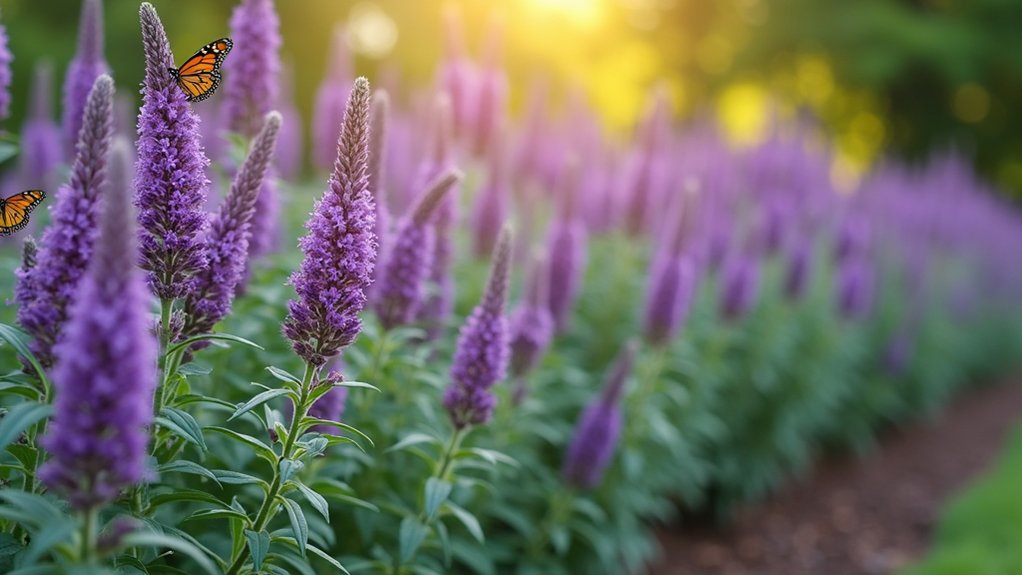
Butterfly bush (Buddleja davidii) creates a stunning living fence that doubles as a wildlife sanctuary, growing up to 12 feet tall with arching branches covered in long, cone-shaped flower clusters.
These fragrant blooms appear in shades of purple, pink, white, or blue from summer through fall, attracting numerous butterflies, bees, and hummingbirds. The plant’s lance-shaped gray-green leaves provide an attractive backdrop for the showy flowers, making it an excellent choice for privacy screening while supporting local pollinators.
- Full sun exposure (6-8 hours daily)
- Well-draining, moderately fertile soil
- pH range of 6.0-7.0
- Moderate watering, allowing soil to dry between waterings
- Drought tolerant once established
- Hardiness zones 5-9
- Spacing 5-6 feet apart for hedge formation
Regular deadheading of spent blooms encourages continuous flowering and prevents unwanted self-seeding, as butterfly bush can become invasive in some regions.
Annual late winter or early spring pruning is essential, cutting back stems to about 12 inches above ground level to maintain shape and promote vigorous new growth.
Remove any dead or crossing branches throughout the growing season, and apply a layer of mulch around the base to suppress weeds and retain moisture, keeping it away from the main stems to prevent rot.
